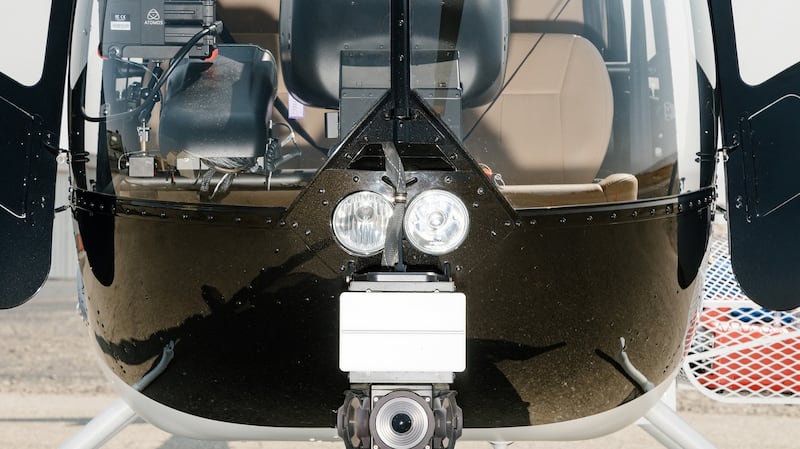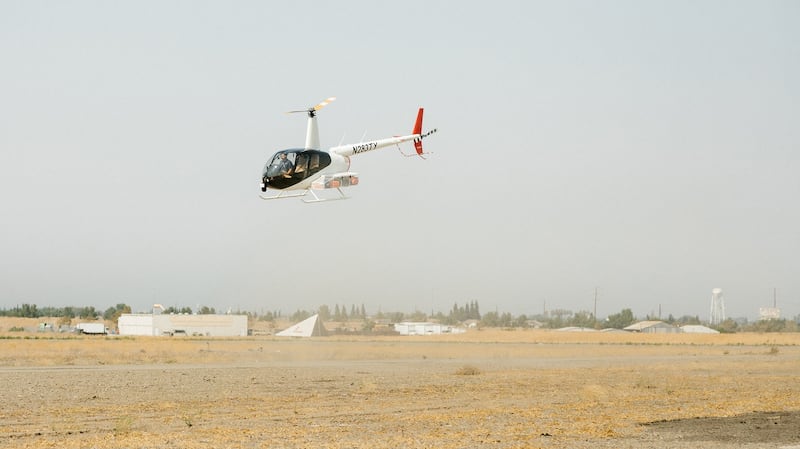Last week, at a tiny airport in the dusty flatlands east of San Francisco, a red-and-white helicopter lifted gently into the air, hovering a few feet over the tarmac. It looked like any other helicopter, except for the small black cube attached to its nose.
Local officials spent the week testing this aircraft for a new emergency service, due for launch in January, that will respond to 911 calls via the air. But as this helicopter moves police officers and medical workers over the San Joaquin Valley, it will feed a more ambitious project. That black cube is part of a growing effort to build small passenger aircraft that can fly on their own.
Today, the helicopter is flown by seasoned pilots. But the new emergency service will be operated by SkyRyse, a Silicon Valley start-up that intends to augment small helicopters and other passenger aircraft with hardware and software that allow for autonomous flight, leaning on many of the same technologies that power driverless cars. These include the 360-degree cameras and radar sensors built into the nose of the aircraft.

"There are many things that must come to fruition before autonomous aircraft start flying people," said Mark Groden, a co-founder and the chief executive of SkyRyse. "But we are developing the technology that can take us there."
Sikorsky, a subsidiary of the defence contractor Lockheed Martin, and Xwing, another Silicon Valley start-up, are fashioning similar technology. Others, including Aurora, a company now owned by Boeing, are exploring autonomous flight as they build a new kind of electrical aircraft for "flying taxi services". The initial business plan for Uber's air taxi service, which it hopes to start in five to 10 years, said it would eventually remove pilots from the aircraft.
The motivation is obvious: Pilots are expensive, and they need rest between flights. Autonomous flight can drive new kinds of passenger services or even change the economics of today’s airlines. As companies like Aurora build aircraft for autonomous flight, entrepreneurs like Mr Groden believe that adapting existing aircraft is more realistic. But any path will take a while, for technical and cultural reasons.
Safe
"This is not just about building something that can fly by itself," said Dan Patt, the chief executive of the robotics company Vecna, who previously worked on autonomous flying with Sikorsky and other companies while he was at DARPA, a research arm of the US defence department. "It is about building a body of evidence that this is a safe way to fly."
Government and industry have long worked to automate portions of passenger flight – “autopilot” is part of the American vernacular – and in some ways, building an autonomous aircraft is easier than building driverless cars, which have long been tested on public roads. Aircraft operate in wide-open spaces, as opposed to narrow roads teeming with pedestrians and other vehicles. And piloting a plane or helicopter is the kind of highly procedural task that computers are typically good at.

Tiny drones have already shown the possibilities of autonomous flight. Skydio, a Silicon Valley start-up founded by former Google engineers, sells a $2,500 drone that can follow you through a forest as you bob and weave between the trees. Adam Bry, the company's chief executive, who also worked on Google's delivery drone project, said the same general technology – based on digital cameras and mathematical systems that analyse images in real time – was suited to passenger aircraft.
“The technical challenge is simpler in a lot of ways,” Mr Bry said. “Nobody wants these things whipping through the forest as fast as they can go. They just want them to fly reliably, carry people from point A to point B, and deal with takeoff and landing.”
But dealing with the uncertainty that comes during takeoff and landing, not to mention the rare and random events that cause crashes in the middle of a flight, can be extremely difficult.

Passenger flight is also highly regulated. Even if they build systems that fly reliably, companies may have trouble moving the technology into public airspace.
That is why SkyRyse, backed by $25 million (€21 million) in funding, including investments from the Silicon Valley venture firms Venrock and Eclipse, is working with the city of Tracy. The Tracy emergency service will operate under current federal rules, and it takes only a step toward autonomy.
The helicopter includes sensors that it would need for autonomous navigation. The radar, for example, is similar to the laser sensors on driverless cars, providing a detailed view of the surroundings even in heavy weather. But at this point, these sensors operate in tandem with pilots. Mr Patt calls it “a way of building trust” with regulators.
At the same time, these sensors capture enormous amounts of data describing what the helicopter encounters from takeoff to landing – and how the pilot responds.
Flight conditions
Using this data, engineers at SkyRyse are re-creating flight conditions in a kind of virtual reality, and they’re fashioning systems that can navigate these simulations. Driverless carmakers rely on similar techniques.
“We can simulate puffs of wind, engine failure, even birds digested into the tail rotor,” Mr Groden said.
But shifting this work into emergency services like the one in Tracy will take years. Moving it into flying taxi services may take even longer.
The helicopters used by SkyRyse – the four-seat Robinson R44 – are small and quiet by existing standards, and in relatively wide use (about 6,000 have been built). But if used in large numbers, they may not be suited to densely populated areas. This is why companies like Aurora and the Silicon Valley start-up Kitty Hawk are building a new kind of aircraft.
Still, the biggest hurdle may be convincing regulators and the public that autonomous flight is safe. "There are a lot of start-ups doing this," Igor Cherepinsky, director of autonomy programs at Sikorsky, said. "Quite a few of them are naïve about what it will take." – New York Times Service



















